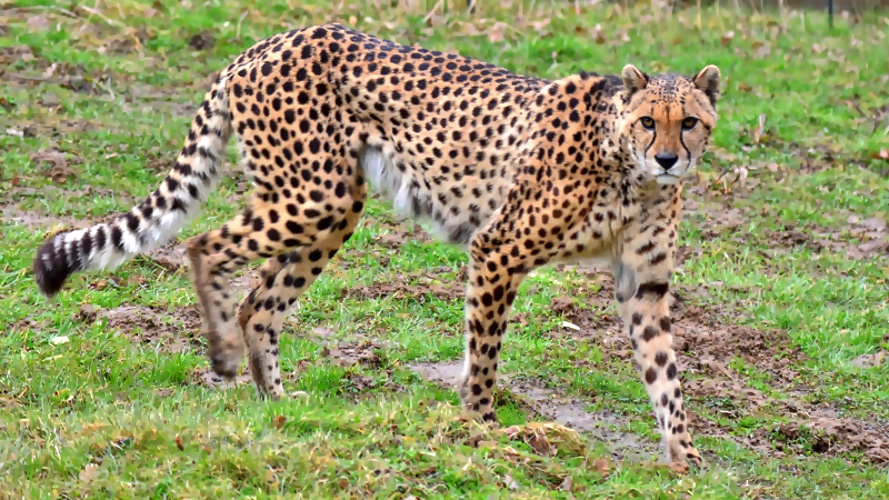

In 1917, Reginald Innes Pocock placed the cheetah in a subfamily of its own, Acinonychinae, given its striking morphological resemblance to the greyhound and significant deviation from typical felid features the cheetah was classified in Felinae in later taxonomic revisions. Joshua Brookes proposed the generic name Acinonyx in 1828.
#Rapidclick gepard skin#
In 1777, Johann Christian Daniel von Schreber described the cheetah based on a skin from the Cape of Good Hope and gave it the scientific name Felis jubatus. TaxonomyĪn illustration of the "woolly cheetah" (described as Felis lanea) from the Proceedings of the Zoological Society of London (1877) Ī few old generic names such as Cynailurus and Cynofelis allude to the similarities between the cheetah and canids. The specific name jubatus is Latin for 'crested, having a mane'. A similar meaning can be obtained by the combination of the Greek prefix a– (implying a lack of) and κῑνέω ( kīnéō) meaning 'to move' or 'to set in motion'. A rough translation is "immobile nails", a reference to the cheetah's limited ability to retract its claws. The generic name Acinonyx probably derives from the combination of two Greek words: ἁκινητος ( akinitos) meaning 'unmoved' or 'motionless', and ὄνυξ ( onyx) meaning 'nail' or 'hoof'. In the past, the cheetah was often called "hunting leopard" because they could be tamed and used for coursing. This in turn comes from Sanskrit: चित्रय ( Chitra-ya) meaning 'variegated', 'adorned' or 'painted'. The vernacular name "cheetah" is derived from Hindustani Urdu: چیتا and Hindi: चीता ( ćītā). They have been widely depicted in art, literature, advertising, and animation. In the past, cheetahs were tamed and trained for hunting ungulates. In 2016, the global cheetah population was estimated at 7,100 individuals in the wild it is listed as Vulnerable on the IUCN Red List. Historically ranging throughout most of Sub-Saharan Africa and extending eastward into the Middle East and to central India, the cheetah is now distributed mainly in small, fragmented populations in central Iran and southern, eastern and northwestern Africa. The cheetah is threatened by several factors such as habitat loss, conflict with humans, poaching and high susceptibility to diseases. The cheetah occurs in a variety of habitats such as savannahs in the Serengeti, arid mountain ranges in the Sahara and hilly desert terrain in Iran. They are weaned at around four months and are independent by around 20 months of age. Cheetah cubs are highly vulnerable to predation by other large carnivores such as hyenas and lions. After a gestation of nearly three months, a litter of typically three or four cubs is born. The cheetah typically stalks its prey to within 60–70 m (200–230 ft), charges towards it, trips it during the chase and bites its throat to suffocate it to death. It feeds on small- to medium-sized prey, mostly weighing under 40 kg (88 lb), and prefers medium-sized ungulates such as impala, springbok and Thomson's gazelles. The cheetah is active during the day, with peaks during dawn and dusk. While females lead a nomadic life searching for prey in large home ranges, males are more sedentary and instead establish much smaller territories in areas with plentiful prey and access to females. The cheetah lives in three main social groups: females and their cubs, male "coalitions", and solitary males. The coat is typically tawny to creamy white or pale buff and is mostly covered with evenly spaced, solid black spots. Its head is small and rounded, with a short snout and black tear-like facial streaks. Adults weigh between 21 and 72 kg (46 and 159 lb). It typically reaches 67–94 cm (26–37 in) at the shoulder, and the head-and-body length is between 1.1 and 1.5 m (3 ft 7 in and 4 ft 11 in). It is the fastest land animal, estimated to be capable of running at 80 to 128 km/h (50 to 80 mph) with the fastest reliably recorded speeds being 93 and 98 km/h (58 and 61 mph), and as such has several adaptations for speed, including a light build, long thin legs and a long tail. The cheetah ( Acinonyx jubatus) is a large cat native to Africa and central Iran. Cynailurus soemmeringii Fitzinger, 1855.


 0 kommentar(er)
0 kommentar(er)
